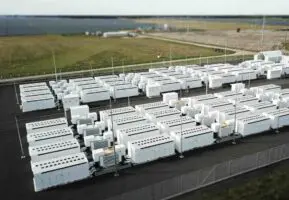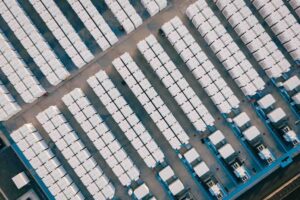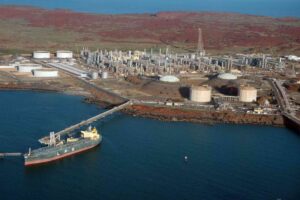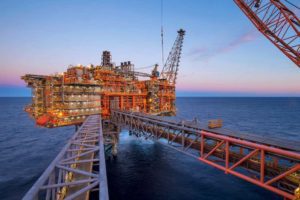
Australian renewable energy developer CWP Renewables has joined forces with global private markets investment manager Partners Group to build a total of 1,300MW of wind, solar and battery projects that they say will beat coal power on price and reliability.
The commitment from Partners Group will see the 135MW Crudine Ridge project south of Mudgee begin construction soon, but Partners will inject a total of $700 million to ensure CWP’s entire 1,300MW portfolio of wind, solar and batteries goes ahead.
The investment is designed, and timed, to take advantage of the closure of Liddell, and is built on expectations that closures of other coal-fired generators will follow.
“We can, from this large portfolio, produce 24/7 baseload renewable power at very competitive prices,” CWP chief executive Alex Hewitt says. “This is the future of large-scale generation in Australia.”
These projects – dubbed the Grassroots Renewable Energy Platform – include the 230MW Sapphire solar farm and 70MWh battery storage, which will combine with the 270MW Sapphire wind farm near Glenn Innes (pictured above) that is nearly complete.
It also includes the 140MW Bango wind project, the Glen Ellen and Sundown solar projects, and the massive Uungula wind and the solar project that will total 400MW of capacity, along with other storage.
Hewitt says these projects will allow morning and evening wind generation to be combined with daytime solar generation and battery energy storage.
This will provide the ability to deliver “base-load” capacity or, at the very least, a “firm” supply of energy for business and other customers. The ability to firm is not just essential for business users, but could also be imperative under the new National Energy Guarantee.
“We see a massive transition away from fossil fuels over the next 10 years,” Hewitt says. “The transition is on. The economics are there, and the window is there now to move really fast.”
CWP is also involved in a huge project – along with Vestas and other international partners – to build 9GW of wind and solar in the Pilbara, to provide power to be exported via a sub-sea cable to south-east Asia, and also to potential customers in Western Australia.
Its announcement follows big plans revealed by Sanjeev Gupta last week for up to 10GW of large-scale solar to underpin the supply of cheap electricity to Australian manufacturers and businesses. Already, 1GW is planned for the Whyalla steel works.
Significantly, the bankers to the $250 million Crudine Ridge project have attributed a zero value to renewable energy certificates, known as LGCs.
“The (futures) price of LGCs is dropping ….and these projects assume no value from those certificates,” Hewitt says.
Hewitt points to problems surrounding Liddell, and the decision of its owner AGL to close down the ageing and decrepit generator because the costs exceed alternatives. Hewitt says it is clear renewables and storage can beat coal generation.
“The cost of these coal plants is becoming way too expensive to continue running, but we are constantly amazed how far solar is falling, and wind is also dropping, and now we have storage,” he says.
Hewitt says the combined cost of wind and solar and “firming capacity” is cheaper than the $100/MWh plus cost of keeping Liddell open, or for that matter building new coal generators.
“We applaud AGL’s stance (to close Liddell) against government pressure. One way or another that amount of generation will be replaced,” he says, noting also that CWP and Partner Group’s own portfolio amounts to 50 per cent of that capacity.
“These projects will help with the transition away from fossil-fuelled electricity in the State,” and Hewitt suggests that other coal-fired generators in the state were also likely to close earlier than previously flagged.
Hewitt says there is huge interest in wind and solar and storage projects from commercial and industrial groups, keen to lower their electricity costs and lock in that discount for long-term contracts.
Deals with energy retailers would also be sought.
Benjamin Haan, the head of private infrastructure in the Asia-Pacific for Partners Group, says its investment in the Sapphire wind farm was designed as an “anchor” to an Australian renewable energy platform.
The combination of 1.3GW of wind and solar under the Grassroots platform offered the scope to be selective and develop a “quality renewables platform of significant scale.
“We look forward to working with the CWP team to further support the generation of clean energy in Australia.”
The Crudine Ridge project has landed a $133 million debt facility provided by the Clean Energy Finance Corporation, Westpac and Sumitomo Mitsui Banking Corporation.
 The CEFC says it is the 10th large-scale wind project it has supported – making up a combined total of 700MW.
The CEFC says it is the 10th large-scale wind project it has supported – making up a combined total of 700MW.
“Large-scale wind projects such as the Crudine Ridge … continue to deliver new sources of revenue and jobs to regional and rural communities, enabling them to tap into the benefits of abundant and low-cost clean energy resources,” said CEFC Wind Investment lead Andrew Gardner.
Meridian Energy Australia has purchased 50 per cent of the estimated 400GWh to be generated by Crudine Ridge to support the growth of its retail business Powershop.
The wind farm, located 45km south of Mudgee in NSW, will be constructed by GE Renewable Energy and Zenviron, who will install 37 x GE 3.63MW wind turbines. The transmission grid connection will be constructed, owned and operated by Transgrid.
The project was advised by ANZ, Deloitte and Norton Rose Fulbright. Partners Group was advised by KPMG and Clifford Chance. Lenders were advised by Aurecon and King & Wood Mallesons.
The Sapphire Wind Farm, which is the largest in the state, has already started delivering to the ACT government, which has contracted 100MW of capacity for its 100 per cent renewable energy target. The project is due for completion this year.
Partners Group is a global private markets investment management firm with over $100 billion in investment programs under management in private equity, private real estate, private infrastructure and private debt.










